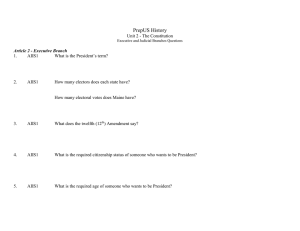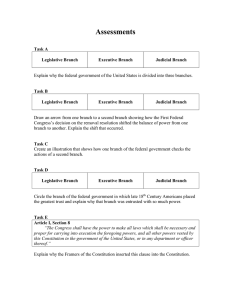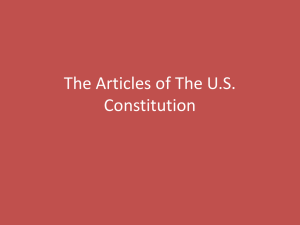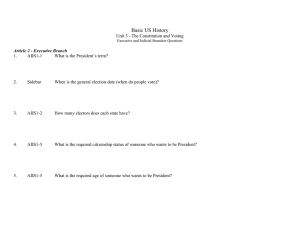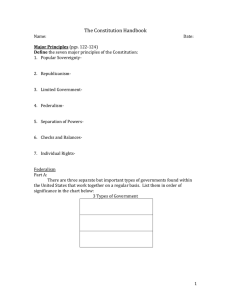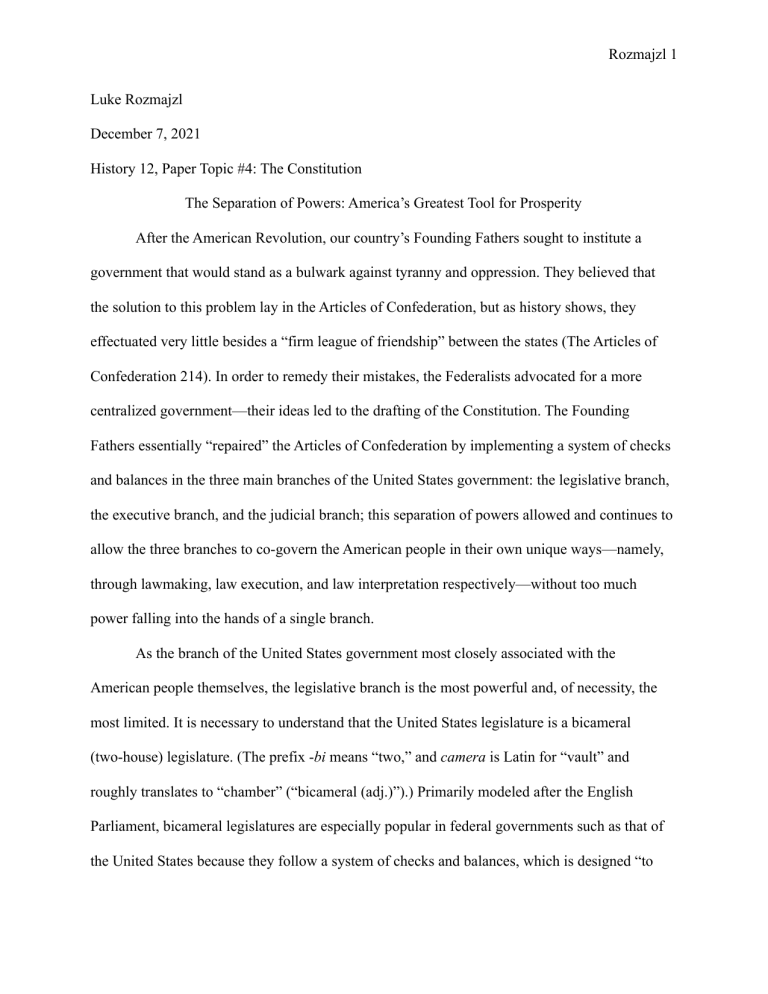
Rozmajzl 1 Luke Rozmajzl December 7, 2021 History 12, Paper Topic #4: The Constitution The Separation of Powers: America’s Greatest Tool for Prosperity After the American Revolution, our country’s Founding Fathers sought to institute a government that would stand as a bulwark against tyranny and oppression. They believed that the solution to this problem lay in the Articles of Confederation, but as history shows, they effectuated very little besides a “firm league of friendship” between the states (The Articles of Confederation 214). In order to remedy their mistakes, the Federalists advocated for a more centralized government—their ideas led to the drafting of the Constitution. The Founding Fathers essentially “repaired” the Articles of Confederation by implementing a system of checks and balances in the three main branches of the United States government: the legislative branch, the executive branch, and the judicial branch; this separation of powers allowed and continues to allow the three branches to co-govern the American people in their own unique ways—namely, through lawmaking, law execution, and law interpretation respectively—without too much power falling into the hands of a single branch. As the branch of the United States government most closely associated with the American people themselves, the legislative branch is the most powerful and, of necessity, the most limited. It is necessary to understand that the United States legislature is a bicameral (two-house) legislature. (The prefix -bi means “two,” and camera is Latin for “vault” and roughly translates to “chamber” (“bicameral (adj.)”).) Primarily modeled after the English Parliament, bicameral legislatures are especially popular in federal governments such as that of the United States because they follow a system of checks and balances, which is designed “to Rozmajzl 2 avoid hasty and harsh legislation, limit democracy, and secure deliberation” (Britannica). As will be seen shortly, this is true for the United States legislature. The legislative branch of the United States government is collectively known as Congress and is divided into two main houses: the Senate and the House of Representatives. Some of Congress's principal powers include: declaring war, raising and supporting an army and a navy, and, most importantly, making “laws which shall be necessary and proper for carrying into execution the foregoing powers, and all other powers vested by this Constitution of the United States . . .” (Constitution, art. I, sec. 8). The Senate and the House of Representatives, although unified under one legislature, vary extensively in structure and have distinct roles. For example, the Senate is composed of 100 senators (two per state), whereas the House of Representatives currently has 435 representatives proportionally elected from the states according to their respective populations. The Senate has the exclusive power to approve treaties entered into by the president and to convict civil officers (usually the president) in impeachment trials. On the contrary, the House of Representatives alone may introduce bills for raising revenue and has the sole authority to impeach civil officers and, by extension, commence impeachment trials. It is evident that the powers of the legislative branch are vast; therefore, it is, unsurprisingly (but somewhat paradoxically), the most limited of all the branches of the United States government. For instance, the judicial branch may deem certain laws passed by Congress as unconstitutional in a process known as judicial review. Additionally, the president may veto bills introduced by Congress. When this happens, the bill in question is sent back to Congress, where it is reconsidered by both houses; if both the Senate and the House of Representatives agree by a two-thirds majority vote to the reconsidered bill, it becomes a law. (This demonstrates the miniaturized system of checks and balances that exists within Congress itself, consequently offering further testimony to the legislative branch’s Rozmajzl 3 immense powers and its resultant need for restriction by the other branches.) Finally, the president may recommend legislation and nominate department heads. Equipped with such knowledge, it is impossible to deny that the influence of the other branches is felt heavily in Congress. The executive branch is, at its very core, the law-enforcing branch of the United States government. Its members include the president, the vice president, the president’s Cabinet (an advisory body made up of the heads of fifteen executive departments), independent agencies, and other boards, commissions, and committees (“Branches”). Overall, the executive branch now employs more than four million Americans (“The Executive Branch”). The president is at the forefront of operations in the executive branch, as he is the head of state, the leader of the government, and the Commander-in-Chief of the United States armed forces. The president may serve in office for a maximum of four years per term and for no more than two terms, provided that he is a citizen of the United States, that he is at least thirty-five years of age, and that he has been a resident within the United States for a minimum of fourteen years. The oath that he must swear upon entering into office aptly summarizes his duty to the United States: “I do solemnly swear (or affirm) that I will faithfully execute the office of President of the United States, and will to the best of my ability, preserve, protect, and defend the Constitution of the United States” (Constitution, art. II, sec. 1). The vice president is, in essence, the president's “left-hand man.” For example, when the president is unable to exercise the duties of his office due to some extraordinary circumstance (e.g., his death), the vice president assumes, either temporarily or permanently, those duties. Lastly, he is the president of the senate. Although the vice president rarely presides over the Senate, his presence there is imperative in the case of tie-breaking votes (“The Executive Branch”). Contrary to popular belief, the executive branch is not the most Rozmajzl 4 powerful branch of the United States government; such a misconception has taken root simply because most people recognize that the president is its most powerful individual. However, the executive branch as a whole does not dominate the other branches—it merely balances them while simultaneously being balanced itself. For instance, the legislative branch may impeach and convict the president for “treason, bribery, or other high crimes and misdemeanors” (Constitution, art. II, sec. 4). As mentioned previously, it may also override any vetoes that he makes (doing so requires both houses of Congress to reach a two-thirds majority agreement) and may either approve or reject any nominations that the president makes for department heads and other appointees. The final check on the executive branch is made by the judicial branch, which may formally declare certain executive acts as unconstitutional. Members of the judicial branch must interpret the law as it is; higher levels of the judicial branch, such as the Supreme Court, have the duty of interpreting the Constitution and of ensuring that its precepts are followed by all members of the United States government. The most important division of the judicial branch is, of course, the Supreme Court, which is presently occupied by one chief justice and eight associate justices. (Note that this number is not fixed. The Tenth Circuit Act of 1863, for example, allowed a total of ten justices to sit in the Supreme Court (Johnson).) Article III, Section 2 of the Constitution briefly lists the powers of the judicial branch. Firstly, “the judicial power shall extend to all cases, in law and equity, arising under this Constitution, the laws of the United States, and treaties made, or which shall be made, under their authority . . .” (Constitution, art. III, sec. 2). Furthermore, the judiciary’s jurisdiction encompasses all cases involving heated international and domestic controversies, such as those arising from interstate conflicts or from quarrels with other nations. Article III, Section 2 also establishes the Supreme Court’s constitutional right to original and appellate jurisdiction: Rozmajzl 5 “[o]riginal jurisdiction is the right of a court to hear a case for the first time. It can be distinguished from appellate jurisdiction[,] which is the right of a court to review a case that has already been heard and decided upon by a lower court” (“Original jurisdiction”). Unlike members of the other branches of government, judges receive lifetime appointments, that is, “during good behaviour” (art. III, sec. 1). (The term “good behaviour” is intentionally ambiguous, but it most likely refers to any form of misconduct that might merit a judge’s impeachment.) Indefinite office durations for judges have actually benefited our country. For instance, they prevent political bias from infiltrating our courts—the Constitution and other laws are rarely altered, and judges are far less likely to succumb to the ever-changing whims of the American people when they do not have to face the threat of being removed from office. Moreover, judges with lifetime appointments can more easily gain experience and, consequently, better serve the public. In response to the anti-Federalists’ understandable doubts about a judicial branch, Alexander Hamilton claimed that it is the “least dangerous branch,” for it has “no influence over the sword or the purse; no direction either of the strength or of the wealth of the society; and can take no active resolution whatever.” It has “neither FORCE nor WILL, but merely judgment . . .” (464). However, there is much debate regarding whether or not his assertion is truly accurate. Consider Marbury v. Madison (1803). Widely viewed as the most important Supreme Court case of all time, it saw the formal recognition of the legal doctrine of judicial review, which allows the Supreme Court to categorize certain actions of the legislative and executive branches as not aligning with the principles of the Constitution (Tate). From this point onwards, the judicial branch’s power in the United States government was dramatically extended beyond its original limits. It is, therefore, fortunate that it too is restricted by the other branches. To illustrate, the legislative branch may propose amendments to the Constitution. It Rozmajzl 6 may also either approve or reject the president’s nomination of a federal judge and even threaten judges with impeachment, that is, if they stray from their duty to maintain “good behaviour.” In like manner, the executive branch may nominate judges for the Supreme Court, which prevents already-instated judges from electing unfit colleagues. Our country’s Founding Fathers undoubtedly possessed a remarkable genius for developing centralized governments that could successfully uphold and defend man’s natural rights to life, to liberty, and to the pursuit of happiness; the very fact that their most precious ideals endure even now attests to this. Their decision to separate the United States government into three branches that limit each other’s powers allows freedom to prevail in our nation. Because of their prudence, the legislative branch, the executive branch, and the judicial branch have been able to dutifully perform their respective tasks of law-making, law execution, and law interpretation while still remaining relatively free from the corruption that too often plagues centralized governments. The United States is no longer just a “firm league of friendship” that is subject to inevitable collapse—it is a concretely established union that will remain for countless years to come. Rozmajzl 7 Works Cited The Articles of Confederation. Modern History Reader, Kolbe Academy Press, 2008, pp. 21420. “bicameral (adj.).” Online Etymology Dictionary, www.etymonline.com/word/bicameral. Accessed 7 Dec. 2021. Britannica, The Editors of Encyclopaedia. “bicameral system.” Encyclopedia Britannica, 14 Aug. 2019, www.britannica.com/topic/bicameral-system. The Constitution of the United States. A Documentary History of the United States, edited by Richard D. Heffner and Alexander B. Heffner, Berkeley, 2018, pp. 16-38. “The Executive Branch.” The White House, www.whitehouse.gov/about-the-white-house/ourgovernment/the-executive-branch/. Accessed 7 Dec. 2021. Hamilton, Alexander. “No. 78: The Judiciary Department.” The Federalist Papers, New American Library, 2003, pp. 463-71. “Original jurisdiction.” Ballotpedia, ballotpedia.org/Original_jurisdiction. Accessed 7 Dec. 2021. “Supreme Court of the United States.” Ballotpedia, ballotpedia.org/Supreme_Court_of_the_ United_States. Accessed 7 Dec. 2021. Tate, C. Neal. "judicial review." Encyclopedia Britannica, 18 Oct. 2019, https://www.britannica. com/topic/judicial-review.

